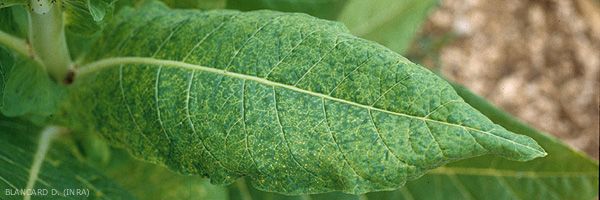
Potato virus Y
(PVY)
- classification : Potyviridae, Potyvirus
Potato virus Y, (PVY) is shown in figure 1. Serological and biological variability of this virus has been mainly studied on strains collected from potato. Two types of strains have typically been reported on tobacco: moderate strains producing mosaic-like symptoms, and severe strains causing necrotic lesions as well as mosaic-like symptoms. In many countries the necrotic strains are generally observed along with mosaic strains and are by far the most damaging.
 |
| Figure 1 |
In addition to the general separation of PVY "tobacco" strains based on symptoms, another classification has been developed in the USA. It allows us to characterise three strains according to their behaviour on two tobacco genotypes, root-knot nematode (Meloidogyne incognita) susceptible (McNair 944) or resistant (NC 95). This classification was based on field observations which revealed that the varieties resistant to M. incognita showed severe necrosis in the presence of a particular strain of PVY. We can thus separate three strains:
- a "MSMR" strain responsible for mosaic-like symptoms ("vein banding", vein clearing, etc.) in both varieties, MN 944 and NC 95;
- a "MSNR" strain causing "mosaic patterns" on MN 944 and severe necrotic symptoms on NC 95, particularly in the vessels;
- a "NSNR" necrotic strain causing necrosis on both genotypes.
In tobacco nematode resistance and induction of severe necrosis in the presence of PVY originate from pleiotropic effects of the same gene.
Further observations on the pathogenic variability of PVY have been reported. A necrotic strain capable of overcoming the recessive va gene, responsible for resistance to PVY, has been demonstrated in an American "NN" strain collection. It is called "VAM-B" (Virgin A Mutant Breaking strain) because it induces severe symptoms in the greenhouse on the otherwise PVY resistant genotype Virgin A mutant (VAM).
More recently, a strain with a similar behaviour has been observed in the field in the USA. Strains with similar virulence have also been reported in other countries, including Hungary, Poland and Italy. In France, such strains have been isolated from several production areas and are of particular concern in the Alsace region. All PVY resistant varieties belonging to the three types of tobacco are affected, especially when tobacco crops are close to potato crops or if potato is grown between tobacco rows. These strains have also been observed in other countries of the American continent, including Chile and Argentina.
Potato virus Y is widespread and occurs more or less seriously on all continents. Europe is particularly affected by this virus, with very aggressive necrotic strains reported in Eastern Europe (Hungary, Bulgaria and Poland), and Western Europe (Spain, Italy and France). In Asia necrotic strains occur as well. They have been reported in China, Japan, Korea and Taiwan. Several African countries are affected, and PVY seems a rather serious problem in North Africa, particularly in Morocco. On the American continent, the situation appears mixed. In North America, although this virus is frequently observed in crops, the prevalent strains do not seem to have the same pathogenicity as the European strains. This is not the case in South America, especially in Argentina and Chile, where severe epidemics caused by necrotic strains of PVY occur.
At the global level, potato virus Y is certainly the most damaging virus of tobacco. The latest survey of CORESTA (Cooperation Centre for Scientific Research Relative to Tobacco) on tobacco viruses confirms this situation. Losses due to necrotic strains of the virus are increasing in many countries. The impact of this virus on Burley and Virginia tobacco is reduction of size and weight of leaves, plant height, and yield. The earlier the infections occur, the greater the impact on the tobacco crop. In Chile and New Zealand heavily infected crops have experienced yield reductions exceeding 70%. The chemical quality of harvested tobacco is also reduced in the presence of PVY. An increase of nicotine, nornicotine, total nitrogen, nitrogen-insoluble acid and nitrate content can be observed. However reducing sugars, phenols and total soluble nitrogen seem to be reduced in leaves infected with PVY.
Although difficult to quantify, the economic losses caused by this virus are important.





